When it comes to air pollution, I am pretty sure the image pops in your mind is something like dark smoke emitting from the back of cars or industrial chimneys and you feel impervious to these when you are sitting on your couch inside your living room. Well, I wish this was the fact but reality is rather grim. The World Health Organization has estimated the death toll of the staggering amount of 4.3 million per year due to household air pollution and root cause for the illness like asthma symptoms, flu, throat irritation, and even lung cancer.
Now, you must be wondering…What in the world…! How is that possible? You will be amazed to learn about the sources of the pollutant. Home construction materials pose asbestos and formaldehyde which are the main contributor. Also, the traditional cooking method and cigarette smokers release harmful chemicals classified as VOC (volatile organic compound). Apart from these, varnish fumes from paint and chemicals from cleaning products, biological agents like mildew, dust mites, mold, and bacteria, along with inadequate ventilation, high temperature and humidity will brew the ultimate killer recipe for you and your loved ones. Even your toaster is also a usual suspect.
This article is not about air pollution. Then you must be wondering why such a long prelude about indoor air pollution. This is only to accentuate the importance of air purifiers and abolish the mindset that the air purifier is a fancy item for rich, obsessed, or phobic people. This high time to get educated about the best air purifiers for smoke.
Why Do You Need an Air Purifier for Cigarette Smoke?
If the arguments and facts mentioned above have not convinced you yet, there is more. Now, you may have not touched a cigarette in your life (unfortunately, smoking weeds does not fall into this category) but your lungs can get damaged or even have cancer. How? The damage is done by passive smoking.
A person who smokes heavily indoors creates a low-lying smoke cloud because tobacco smoke inside a room tends to hang in mid-air rather than disperse. Initially, hot smoke rises, but as tobacco smoke cools rapidly, it stops its upward climb. As the smoke is heavier than the air, the smoke starts to descend. Other householders have no choice but to breathe the fume.
There are around 7,000 chemicals tobacco smoke contains and it’s made up of particles and gases, over 70 of which are known carcinogenic. Passive smoking has been confirmed as a cause of not only lung cancer but also breast cancer, nasal sinus cancer, throat cancer, and loss of lung function among others in humans by several leading health authorities.
Passive smoking poses a serious threat to pregnant women and unborn babies. Some of the symptoms are:
- Low birth weight and premature baby
- Miscarriage
- Complication during birth
- Sudden unexpected death in infants
Compounds such as ammonia, sulfur, and formaldehyde are especially harmful to people with respiratory conditions such as bronchitis or asthma. They also irritate the eyes, nose, throat, and lungs.
Other sources of danger are fireplaces and conventional stoves for cooking. The smoke emitted from them could be equally harmful.
Now, if you are comparing your living room with the front line of the First World War, I can’t blame you. But, there is hope. Some simple measures can cut down the level of pollution significantly. Among these methods, the air purifier designed to catch the harmful particle of smoke is quite full proof measure if you choose the right equipment.
The air purifiers available in the market offer different designs and some of them are specialized in filtering smoke. High-quality air filters with activated carbon or HEPA filters get rid of smoke as well as foul odor inside your home and they will exchange air 4 to 6 times every hour. Thus they will deliver fresh air every 10 to 15 minutes.
Other Benefits of Using a Smoke Air Purifier
Smoke air purifiers designed to clear smoke particles will improve the other aspects of your dwelling space. When they run, they will eliminate mold spores, dust, pet dander, bacteria, gaseous chemicals, and vapors. Although they remove fine dust suspended in the air, they shouldn’t be considered as the alternative of a vacuum cleaner.
Besides the harmful effect of cigarette smoke, It’s very essential for asthma patients that the air inside the room is free from allergens. Now, if you use a high-end vacuum cleaner (which may have HEPA filters, too) will trap the allergens. But it’s not practical to use the vacuum cleaner every two or three hours. An air purifier will support all day to ensure the quality of air of your house.
How Does an Air Purifier Work for Smoke Removal?
Several mechanisms exist for an air purifier to function. The most common method is mechanical filtration. Air is forced through a filter and particles get trapped physically.
Other mechanisms include:
- Activated carbon: as described earlier, it absorbs chemicals through its large surface area.
- Ultraviolet germicidal irradiation: ultraviolet light is a known germicide. When UV light shines on germs their cell materials get destroyed by the high energy photon. A fan forces the air past UltraViolet light containing microorganisms. A mechanical filter is required to collect dead germs and other dirt afterward.
- TiO2: along with calcium carbonate, the nanoparticle of TiO2 neutralizes any acidic gasses.
- Ozone generator: in this system, a significant amount of ozone gas is generated which is a strong oxidizer. This gas is then mixed with the chemical substance the air contains. When chemicals react with oxidizer their chemical properties change and they become benign. It is capable of removing smoke odor, mold and another foul stench of rotten flesh, musty floor, etc. but one should be very cautious using this unit as high concentration ozone is dangerous for humans. The only safe use of this unit is inside an empty room.
- Ionizer purifiers: the charged electrical surface produces ions that are electrically charged. These charged ions attract airborne particles and are then collected by an electrostatically charged plate. A trace amount of ozone is generated in this process which is not harmful.
- Photocatalytic oxidizer: in this scheme, short-wavelength UV light is used with the TiO2 catalyst which completely oxidizes and degrades organic pollutants. Inside the unit, there is a UV light source and a metal sheet covered with TiO2. When UV light hits the metal sheet the catalyst is activated. A chemical reaction between moisture and other molecules in the air occurs and turns them into harmless substances. It’s an emerging technology in the air purifier system.
Other experimental methods exist and air purifiers combine multiple methods to achieve the expected goal. All the air purifiers must have a suitable filter to capture the intended particle. The filter can be designed to catch a particle of a specific size. But filters alone can’t purify chemicals. To do that, other methods like activated carbon, ozone, etc. are required. A careful combination of mechanisms and design consideration yield the best result.
In short, an effective air purifier filters the air absorbs the chemical and destroys microorganisms inside your room.
What to Consider Before Buying Air Purifiers for Smoke
If you are not careful there are chances you waste your money over the wrong equipment. It was discussed earlier that smoke filtering air purifier is not very common.
- Specifications: since every air purifier is not designed to remove smoke, you have to look for specifications. A smoke removing air filter must have an absorption medium like activated carbon, TiO2 nanoparticle or ionizer along with a high-quality mechanical filter. Without the medium, an air filter will clean some airborne dust but not smoke. The activated carbon is the most popular option.
Also, the size of your living space will affect the performance of the device. So, don’t forget to measure the size of your room before buying it. The configuration and size of the room don’t guarantee that all air will pass through the purifier.
- Health threat: some air purifiers, especially the one with an ozone generator will produce concentrated levels of ozone which can be toxic. Some other purifiers also produce ozone as a byproduct. You must have to consult the manufacturer’s literature, before using it. You may have to run some purifiers when nobody is around.
- Quality: it’s quite a challenge to find the right equipment since a myriad of variations are available. But if you prefer performance, you can’t compromise on quality. Some air purifier brands offer washable plates that aren’t very effective. The HEPA standard filters are rather effective but they are not cheap and they are not reusable. It has been found that replaceable filters are well suited.
- Noise level: since air purifiers are indoor units, quiet operation is desirable. A noisy unit will constantly interrupt your activity and it can be very irritating. Also, it’s bad for your hearing. Turn on your air purifier and check the sound it makes before buying.
- Annual cost: the air purifiers need replacing parts like filters, activated carbon, etc. on a regular basis. So, estimate the annual cost along with your electricity bill beforehand.
- Warranty and after-sales service: these are crucial topics, too. An air filter with an inadequate warranty period believed to be of poor quality. If you long for an air filter with more life span then look for a unit with 3-5 years of warranty. Good after-sales service ensures the hassle-free support and replacement parts if needed.
10 Best Air Purifiers for Smoke
1. Mighty Air Purifier with True HEPA and Eco Mode
This award-winning compact designed purifier is very powerful and features cutting edge technologies. It will cover almost 361 sq. ft. of space and purifies air through a 4-stage filtration system ( pre-filter, deodorization filter, HEPA filter, and vital ion). Built-in air quality sensors will crank up the purifier in case of heavy smoke and also, saves energy when air is relatively clean. Moreover, there are timers, filter life indicator, manual control for fan speed. The unit has a prefilter and it is wrapped with plastic. Don’t forget to unwrap it before starting.
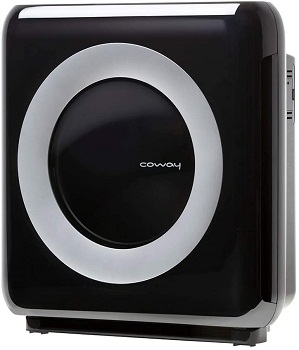

- Large space coverage
- Multistage purification
- Energy efficient (77 watt)
- Little noise (24.4 dB to 53.8 dB)
- Filters and carbon need replacing
- At top speed, noise is intense
2. Honeywell 50250-S True HEPA Air Purifiers for Smoke
Honeywell air purifiers use patented 360° air intake and discharge technology to attain maximum efficiency and allow them to be positioned anywhere inside the room. The indicator light tells you when to change the filter. It’s proven to be very effective for pet dander, pollen, volatile organic compounds (VOC) and microorganisms. It also filters tobacco smoke perfectly. An area of 390 sq. ft. will be covered by it.
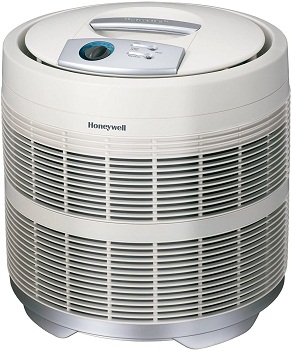

- Effective for cigarette smoke.
- Easy replacing of filter
- Filter life indicator
- Suitable for big area
- No plastic smell
- Blue indicator light can be disturbing during night
- Pre-filter needs replacing every 3 months.
3. PureZone 3-in-1 Air Purifiers for Smoke – True HEPA Filter
Pure Enrichment PureZone 3-in-1 Air Purifier: the built-in UV light, carbon, and HEPA filter provide a deeper level of air sanitation. But it’s a small unit of 60 watt and works on a space of about 200 sq. ft… It has a special night setting for quiet and without light operation during the night. Also, a timer with 2, 4, and 8-hour settings and a fan with 3-speed settings are available. PureZone filters tobacco smoke perfectly. The performance will be increased if the pre-filter is vacuumed or washed with soap water.


- Special night mode
- Low noise level (30 dB)
- Long-lasting pre-filter (6 months).
- Suitable for small room only
- Plastic smell
4. Dyson Pure Cool, TP04 – HEPA Air Purifiers for Smoke
Dyson purifier is a pretty high tech one featuring wi-fi connectivity and a dedicated Dyson link app. It can also be voice-controlled by Alexa. Apart from that, it has a HEPA filter, activated carbon and backward airflow to purify the air without changing the temperature. It distributes air evenly over the whole area using air multiplier technology. Night mode is also incorporated.
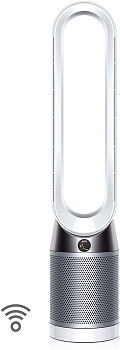

- Hi-tech
- Stylish design
- Better and enhanced air circulation
- Oscillating fan
- Intelligent sensors
- Price
- Noise
- Filter replacement at every 6 months
5. Blue Pure 411 Air Purifiers for Smoke & Home
This is simple, one-button control and user-friendly purifier come with a 3 stage purification system. This unit is very energy-efficient and consumes 30 watt. The pre-filters are washable and it runs quietly. It’s designed for a small room.
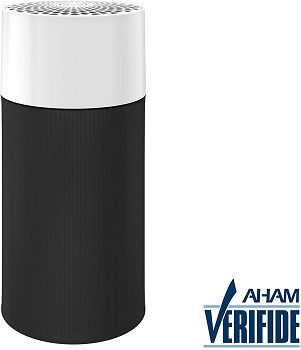

- Low energy consumption
- Low noise (17-46 dB)
- Easy access to per filter
- No sensors
- Small area coverage
- No filter life indicator
- Filter changing after 6 months
6. RENPHO Air Purifier with True HEPA Filter
Designed in the white stylish outer casing, this unit offers 3 stage purification. It has a sleep mode and 3 adjustable speeds for the fan. Filter replacement indicator flashes when it’s time to replace. There are no byproducts and they are quite safe for humans. It will cover a space of 103 sq.ft.
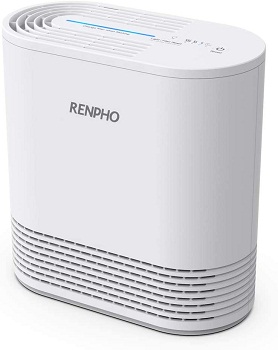

- Price
- Safe
- Low noise level
- Easy access to the filter
- Filter replaces indicator
- Small area coverage
- Replacing filter every 6 months
7. Germ Guardian True HEPA Filter Air Purifiers for Smoke
Germ Guardian True HEPA Filter Air Purifier: This is one of the best air purifiers which includes HEPA filter, activated carbon and ultraviolet light. The UV light kills germs and activated carbon captures chemicals and odor. The UV light can be turned off during normal operation. It is designed for small and medium rooms. In its lowest setting, it runs rather quietly.


- Kills germs
- Improve condition for asthma patient
- You will get under$100
- Plastic burning smell is emitted sometimes.
- Small area coverage
8. LEVOIT Air Purifier for Home Allergies
Designed for 215 sq. ft. area, the Vortexair technology creates stronger airflow very quietly ( only 24 dB noise level). The display can be turned off to avoid disturbance during the night. Other features are 3 different fan speeds, check filter indicator, timer, and display lock option. Manufacturers offer customized filters for pet allergy, toxin absorber, and mold bacteria filters along with the original filters.


- Ultra-quiet
- Large area coverage
- Price(best air purifier for smoke under $100)
- Slight vibration sometimes.
- Plastic smell when purchased new
9. Hamilton Beach TrueAir Air Purifier for Home or Office
It has a great tower design and stylish look. It’s very easy to move and can be placed horizontally or vertically to fit in the space of 160 sq. ft. But it doesn’t come with a true HEPA filter. This filter is claimed to be reusable after vacuum cleaning.
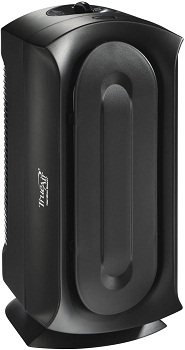

- Reusable filter
- Sleek design
- Versatile positioning
- Can’t be used in a kitchen or in a place with oil and grease
- Filter is attached permanently.
10. LEVOIT Air Purifier for Home Bedroom
Here is another LEVIOT unit with 3 stage filtration system: activated carbon, true HEPA filter, and pre-filter. It’s great for pet dander, dust, pollen, mold, and harmful germs. The 1-12 hour timer provides flexibility to choose when and how long the unit will run. It has an auto mode as well as 3 stages manual speed setting. During the night, you can turn off the LED display and the noise level is only 52 dB. It will cover 360 sq. ft. area.
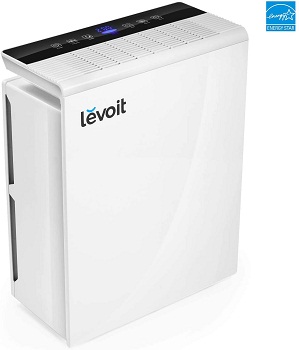

- 100% ozone free
- Low noise level
- Night mode
- Auto mode sometimes fail to purify efficiently
- Uneven fan noise
What Is the Best Air Purifier (system) that Removes Smoke?
As mentioned earlier, different air purifiers use different mechanisms and they are tailored for different purposes. Most of the air purifiers are designed to filter particles like molds, dust and pet dander because of the market demand. Filtering smoke is a special purpose and calls for special designs. For absorbing smoke, two types of filters are the front runner:
- HEPA filter: the term is the abbreviation of “High-Efficiency Particulate Absorbing”. It’s a standard for mechanical filters and to meet the standard, the filter must remove 99.7% of particles whose diameter is equal to 0.3 micrometers. The essential design of the filter features a mat of randomly arranged fibers (normally fiberglass with a diameter of 0.5 to 2 micrometers). Inside the filter, particles are trapped through a combination of mechanisms.
- Activated carbon filter: this filter absorbs chemicals and odors and neutralizes them. The activated carbon filter is made of millions of small pores which increases the surface area of the filter. Gas molecules are absorbed by this large surface and changed from gaseous to the solid phase. After that, it will be collected by a mechanical filter.
So, any air purifier designed to neutralize smoke completely must incorporate both these filters. There are different types of filters available for air purifiers. Look for the filters which meet the HEPA standard.
Pros & Cons of Air Purifying Systems
The air purifiers are differentiated by different types of mechanisms discussed above. Those mechanisms have their own flaws and advantages. Let’s look at some of those.
HEPA Filter
- Filter most of the allergens like mold spores, dander, dust mites, and pollen.
- Filter most airborne bacterias, too.
- Captured particles remain trapped and don’t get released.
- High efficiency (99.7%)
- Cost
- Less than 0.3 microns particles don’t get filtered.
- Unable to absorb chemicals and remove odors.
Activated Carbon
- Absorbs all most every kind of gaseous chemicals, odors, and fumes
- Contaminants remain trapped
- Inexpensive
- Need regular replacing
- Poor performance filtering biological agents and dirt
Ultraviolet light
- Best known for eliminating biological agents like mold, bacteria and other germs.
- Safe to use, no by product
- Doesn’t need regular replacing
- Dead germs don’t get trapped
- Ineffective for dust and other airborne particles
- Also, ineffective for chemicals and odor
- Trace amount of ozone as a byproduct
Ionic
- Inexpensive
- Works on chemical gas and odor
- Neutralizes less than 0.01-micron particles by electrostatic charge
- Quiet
- Charged particles are spread over the room surface and they can be airborne by slight disturbance.
- Ozone is generated
Photocatalytic oxidizer: although it’s a new technology, it’s quickly gaining popularity.
- Effectively purifies air by changing the chemical substance in the air
- Better performance than UV filter or TiO2 filter.
- Trace amount of chemical byproduct (ozone and hydroxyl radicals)
- Limited lifetime
ozone
- Inexpensive
- Treats air by oxidizing harmful chemicals
- Destroys microorganisms
- Doesn’t filter dust.
- Health hazard. This type of filter must operate in an empty room
It should be evident by now that every unit has unique characteristics. If they are combined together according to these characteristics, they will serve the purpose. For example, if a purifier installs both activated carbon and a HEPA filter together, then it will eliminate most of the dust as well as chemicals, smoke particles and odor. Thus different combinations of methods serve different purposes of an air purifier.
Cigarette Smoke Air Purifiers & Smoke-Reducing Tips
If you feel that air purifier isn’t enough to improve your situation, here are some additional tips to help:
- It’s always the best idea to eliminate the source. To keep your living room fresh and clean, indoor smoking should be stopped. Remember, passive smoking is seriously bad for health.
- You can discourage others by asking them to consider the risk involved in passive smoking
- Use a designated area for smoking. It will be easier to clean afterward.
- Another solution is an outside vented exhaust fan for the smoking room. It will increase the efficiency of your air purifier as the majority of the smoke is vented already and it can easily clean the residual particles
- Cheap air purifiers will not improve the air
- Run the purifier throughout the entire day to stop off-gassing.
How to Install, Use and Maintain Your Smoke Air Purifier
Installation: Most of the air purifiers these days are plug and play. After purchase, all you have to do is to unwrap the unit and the filter and plug it. But placing the unit needs some considerations.
As the purifiers collect air and filter it, shoving it in a cramped space will negatively affect it. Put the unit in a place where nothing obstructs the free flow of air. Keep a minimum clearance of 24 inches around all sides including the top.
Use: if the automatic mode is available then it would be most convenient, just turn it on in that mode and let the machine do the work.
Some purifiers have dials to adjust fan speed and match the condition of the room (i.e. no smoke, high smoke, etc.). They also have other features like sleep mode, timer, filter change indicator, and many more.
Maintenance: A major maintenance issue for an air filter is to change the mechanical filter unit in time. Otherwise, it will do more harm than good. Refer to the manual for the appropriate time for changing the filter. Different purifiers have filters of different lifetime i.e. the Leviot air purifier recommends 6-8 months for the filter where the Rabbit Air MinusA2’s filter will last for 2 years.
There may be additional items like pre-filter, activated carbon filter, etc. and they have to be replaced or cleaned periodically and preemptively. If the unit is fitted with a particle sensor, it has to be cleaned properly. This thing saves energy and if not clean, it might cost you a large electricity bill.
Check the manual for cleaning methods and materials. Most of the time, the cleaning process involves cotton swab and isopropyl alcohol. The sensors and other accessories are fitted in a place which is normally easy to access for maintenance purpose.
Frequently Ask Questions on Air Purifiers for Smoke
Do air purifiers get rid of cigarette smoke?
Yes. Smoke contains thousands of tiny particles. The HEPA filter can capture the visible smoke. As for odor, activated carbon filters or others are needed.
Do air purifiers help with wildfire smoke?
Theoretically, they can. It depends on the size of the purifier and commercial air purifiers have limited capability. They can hardly compete with large wildfires. In the case of a small incident, they may help but their filter and absorbing medium will deteriorate fast.
Can you run an air purifier all the time?
Yes, actually it’s ideal to keep it running all the time. Otherwise, dust and allergens will pile up. When soot and ashes pile up, they release harmful chemicals. This phenomenon is referred to as “off-gassing”. To prevent it, air purifiers have to run continuously. Most of these units have built-in intelligent sensors and timers to prevent energy wastage.
Final Thoughts
If you are unable to stop smoking and other pollution inside your room, you must hurry and act accordingly for the safety of your loved ones and yourself. Apart from smoke purifiers, there are other methods too. In case you have decided to pursue the air purifier, you are to maintain your unit properly. Otherwise, it will fail to protect you.
The air purifier for smoke will serve in households as well as office spaces under certain conditions. You have to be very keen on maintenance issues. Also, cheap products may not perform well. These units may be tailored for different purposes like removing allergen and mold. So, you have to be specific during purchase if you want to get rid of smoke because it is a challenging task for air purifiers in general.
Additional Resources: Robotic Vacuum Cleaner Review
